Themed collection Sensors for health and happiness

Recent progress in chemosensors based on pyrazole derivatives
This review provides an overview on the recent (2016–2020) findings on chemosensors based on pyrazole derivatives. The discussion focuses on the design, physicochemical properties and practical applications of probes.
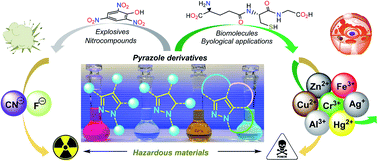
RSC Adv., 2020,10, 19693-19712
https://doi.org/10.1039/D0RA02394A
Nanotechnology-based approaches for food sensing and packaging applications
The advancement of nanotechnology has provided opportunities for the development of new sensing and food packaging solutions, addressing long-standing challenges to extend shelf-life, reduce waste, assess safety and improve the quality of food.
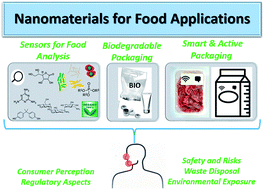
RSC Adv., 2020,10, 19309-19336
https://doi.org/10.1039/D0RA01084G
Carbon and graphene quantum dots: a review on syntheses, characterization, biological and sensing applications for neurotransmitter determination
Carbon and graphene quantum dots for biological and sensing applications of neurotransmitters.

RSC Adv., 2020,10, 15406-15429
https://doi.org/10.1039/D0RA00799D
Flexible potentiometric pH sensors for wearable systems
This review presents recent progress, importance, requirements and future needs of wearable potentiometric pH sensors for healthcare applications.
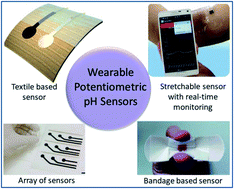
RSC Adv., 2020,10, 8594-8617
https://doi.org/10.1039/D0RA00016G
The medical application of terahertz technology in non-invasive detection of cells and tissues: opportunities and challenges
Terahertz (THz = 1012 Hz) spectroscopy has shown great potential in biomedical research due to its unique features, such as the non-invasive and label-free identification of living cells and medical imaging.

RSC Adv., 2019,9, 9354-9363
https://doi.org/10.1039/C8RA10605C
A review on graphene-based nanocomposites for electrochemical and fluorescent biosensors
Biosensors with high sensitivity, selectivity and a low limit of detection, reaching nano/picomolar concentrations of biomolecules, are important to the medical sciences and healthcare industry for evaluating physiological and metabolic parameters.
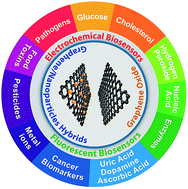
RSC Adv., 2019,9, 8778-8881
https://doi.org/10.1039/C8RA09577A
Small-molecule fluorescent probes and their design
Small-molecule fluorescent probes allow light to be used as a tool to advance the study of biology, discover new drugs, and further the detection of cancer. This tutorial review introduces important concepts related to fluorescent probe development.
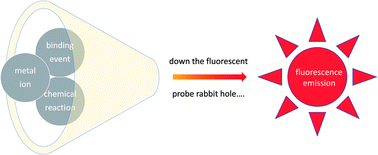
RSC Adv., 2018,8, 29051-29061
https://doi.org/10.1039/C8RA02297F
Recent advances in non-enzymatic electrochemical glucose sensors based on non-precious transition metal materials: opportunities and challenges
We summarize the latest advances of non-enzymatic glucose detection using non-noble transition metal materials, highlighting their opportunities and challenges.
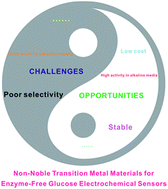
RSC Adv., 2016,6, 84893-84905
https://doi.org/10.1039/C6RA12506A
Optical temperature sensing of rare-earth ion doped phosphors
Optical temperature sensing is a promising method to achieve the contactless temperature measurement and large-scale imaging. The current status of optical thermometry of rare-earth ions doped phosphors is reviewed in detail.
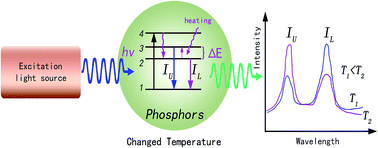
RSC Adv., 2015,5, 86219-86236
https://doi.org/10.1039/C5RA16986K
Optical sensor: a promising strategy for environmental and biomedical monitoring of ionic species
In this review, we cover the recent developments in fluorogenic and chromogenic sensors for Cu2+, Fe2+/Fe3+, Zn2+ and Hg2+.

RSC Adv., 2015,5, 72150-72287
https://doi.org/10.1039/C5RA11388A
Electrically conductive polymers and composites for biomedical applications
This paper provides a review of the recent advances made in the field of electroactive polymers and composites for biomedical applications.
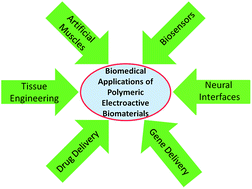
RSC Adv., 2015,5, 37553-37567
https://doi.org/10.1039/C5RA01851J
Graphene and its nanocomposite material based electrochemical sensor platform for dopamine
In this review, the recent progress in the electrochemical sensing of dopamine with various graphene and their nanocomposite materials modified electrodes are presented.
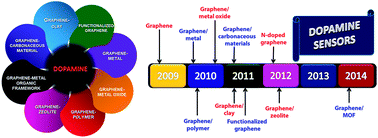
RSC Adv., 2014,4, 63296-63323
https://doi.org/10.1039/C4RA13777A
Recent advances in electrochemical glucose biosensors: a review
Glucose detection is of great significance in biomedical applications. Principles, methods and recent developments in electrochemical glucose sensors are reviewed here.
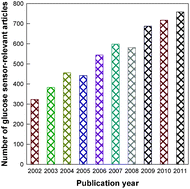
RSC Adv., 2013,3, 4473-4491
https://doi.org/10.1039/C2RA22351A
Nanomaterials for electrochemical non-enzymatic glucose biosensors
This review summarizes some recent progress in the development of nanomaterials for electrochemical non-enzymatic biosensors.
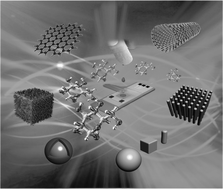
RSC Adv., 2013,3, 3487-3502
https://doi.org/10.1039/C2RA22360K
Wearable silver nanowire dry electrodes for electrophysiological sensing
We present wearable dry electrodes made of silver nanowires for long-term electrophysiological sensing such as electrocardiography and electromyography.

RSC Adv., 2015,5, 11627-11632
https://doi.org/10.1039/C4RA15101A
Hemin-doped metal–organic frameworks based nanozyme electrochemical sensor with high stability and sensitivity for dopamine detection
Hemin-doped-HKUST-1 nanozyme has been successfully synthesized and used for dopamine detection with excellent reproducibility, stability and anti-interference.
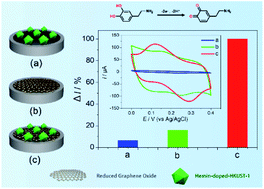
RSC Adv., 2021,11, 2446-2452
https://doi.org/10.1039/D0RA08224D
A dopamine electrochemical sensor based on a platinum–silver graphene nanocomposite modified electrode
A platinum–silver graphene nanocomposite was synthesized and characterized. A nanocomposite modified electrode was fabricated in order to investigate the electrochemical detection of dopamine.
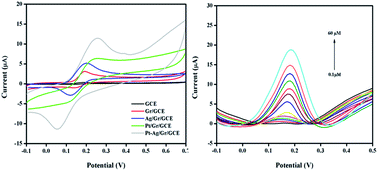
RSC Adv., 2020,10, 17336-17344
https://doi.org/10.1039/C9RA11056A
Aqueous-phase detection of antibiotics and nitroaromatic explosives by an alkali-resistant Zn-MOF directed by an ionic liquid
An alkali-resistant 3D anionic Zn-MOF directed by [BMI]Br ionic liquid has been synthesized for aqueous-phase detection of antibiotics and nitroaromatic explosives.

RSC Adv., 2020,10, 1439-1446
https://doi.org/10.1039/C9RA08733H
Three-dimensional paper-based microfluidic electrochemical integrated devices (3D-PMED) for wearable electrochemical glucose detection
A three-dimensional paper-based microfluidic device (3D-PMED) has been developed for dynamic sweat metabolite monitoring with continuous sweat flow avoiding accumulation.

RSC Adv., 2019,9, 5674-5681
https://doi.org/10.1039/C8RA09157A
Electrochemical sensor based on a three dimensional nanostructured MoS2 nanosphere-PANI/reduced graphene oxide composite for simultaneous detection of ascorbic acid, dopamine, and uric acid
A three dimensional (3D) nanostructured composite based on the self-assembly of MoS2 nanospheres and polyaniline (PANI) loaded on reduced graphene oxide (denoted by 3D MoS2-PANI/rGO) was prepared via a feasible one-pot hydrothermal process.

RSC Adv., 2019,9, 2997-3003
https://doi.org/10.1039/C8RA09511F
Wet-chemically prepared low-dimensional ZnO/Al2O3/Cr2O3 nanoparticles for xanthine sensor development using an electrochemical method
This is a simple route to detect the selective xanthine with wet-chemically prepared co-doped ZnO/Al2O3/Cr2O3 nanomaterials by reliable electrochemical method at large scales for the safety of healthcare fields.
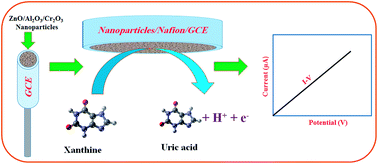
RSC Adv., 2018,8, 12562-12572
https://doi.org/10.1039/C8RA01734D
A label-free electrochemical platform for the highly sensitive detection of hepatitis B virus DNA using graphene quantum dots
Based on the interaction between single-stranded probe DNA and graphene quantum dots (GQDs), we have designed a simple but smart electrochemical platform to detect HBV-DNA by using GQDs modified glassy carbon electrode coupled with probe DNA.
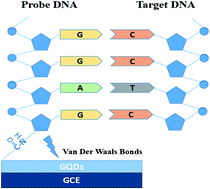
RSC Adv., 2018,8, 1820-1825
https://doi.org/10.1039/C7RA11945C
Hydrothermal synthesis of nitrogen-doped carbon quantum dots from microcrystalline cellulose for the detection of Fe3+ ions in an acidic environment
Nitrogen-doped carbon quantum dots prepared with microcrystalline cellulose display excellent sensitivity to Fe3+ via dynamic quenching in an acidic environment.

RSC Adv., 2017,7, 44144-44153
https://doi.org/10.1039/C7RA08400E
Electrochemical design of a new nanosensor based on cobalt nanoparticles, chitosan and MWCNT for the determination of daclatasvir: a hepatitis C antiviral drug
Daclatasvir (DAC) is listed on the World Health Organization's list of essential medicines needed in a basic health system, therefore, electrochemical and impedance spectroscopic methods are necessary.
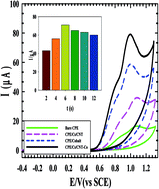
RSC Adv., 2017,7, 1118-1126
https://doi.org/10.1039/C6RA25826C
Non-enzymatic simultaneous detection of L-glutamic acid and uric acid using mesoporous Co3O4 nanosheets
Co3O4 nanosheets were synthesized by wet chemical technique at low-temperature in alkaline phase.
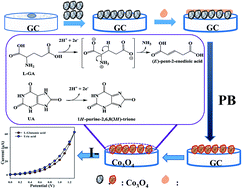
RSC Adv., 2016,6, 80511-80521
https://doi.org/10.1039/C6RA12256F
A biocompatible serine functionalized nanostructured zirconia based biosensing platform for non-invasive oral cancer detection
Schematic of captured antigen onto BSA/anti-CYFRA-21-1/serine/nZrO2/ITO immunoelectrode and its electrochemical response.

RSC Adv., 2016,6, 77037-77046
https://doi.org/10.1039/C6RA07392A
Green synthesis of carbon quantum dots from lemon peel waste: applications in sensing and photocatalysis
Water soluble carbon quantum dots were synthesized from lemon peel waste and were used for Cr6+ detection and photocatalytic degradation of methylene blue dye.
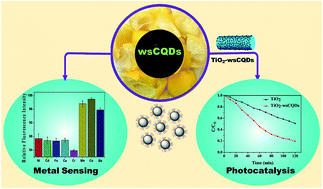
RSC Adv., 2016,6, 72423-72432
https://doi.org/10.1039/C6RA10488F
ZnO/Ag/Mn2O3 nanocomposite for visible light-induced industrial textile effluent degradation, uric acid and ascorbic acid sensing and antimicrobial activity
Ternary ZnO/Ag/Mn2O3 nanocomposite as photocatalyst, sensing and antimicrobial material.
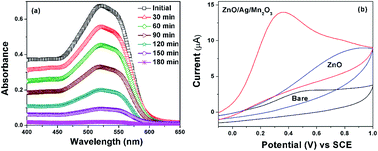
RSC Adv., 2015,5, 34645-34651
https://doi.org/10.1039/C5RA02557E
Wearable temperature sensor based on graphene nanowalls
This work reports an ultrasensitive wearable temperature sensor based on GNWs/PDMS for personalized healthcare and human–machine interface systems.

RSC Adv., 2015,5, 25609-25615
https://doi.org/10.1039/C5RA00871A
Nitrogen-doped graphene quantum dots-based fluorescent probe for the sensitive turn-on detection of glutathione and its cellular imaging
Fluorescence turn-on sensor based on nitrogen-doped graphene quantum dots can be used for glutathione detection in living cells.

RSC Adv., 2014,4, 52583-52589
https://doi.org/10.1039/C4RA10601F
Gold nanoparticle-decorated MoS2 nanosheets for simultaneous detection of ascorbic acid, dopamine and uric acid
Gold nanoparticle-decorated MoS2 nanosheets for simultaneous detection of ascorbic acid, dopamine and uric acid with high sensitivity and selectivity.

RSC Adv., 2014,4, 27625-27629
https://doi.org/10.1039/C4RA04046E
One-pot green synthesis of nitrogen-doped carbon nanoparticles as fluorescent probes for mercury ions
Fluorescent nitrogen-doped carbon nanoparticles (FNCPs) were synthesized by one-pot hydrothermal treatment of strawberry juice. The strategy was simple, green, and low-cost. The as-prepared FNCPs showed some excellent properties such as water-soluble and good stability, which was applied as an Hg2+ sensor with high sensitivity and selectivity.

RSC Adv., 2013,3, 21691-21696
https://doi.org/10.1039/C3RA43452D
Graphitic carbon quantum dots as a fluorescent sensing platform for highly efficient detection of Fe3+ ions
Reported here is a green and facile synthesis of graphitic carbon quantum dots as a fluorescent sensing platform for the highly sensitive and selective detection of Fe3+ ions.
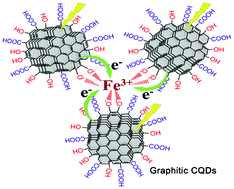
RSC Adv., 2013,3, 3733-3738
https://doi.org/10.1039/C3RA23410J
One-pot green synthesis of Ag nanoparticles -graphene nanocomposites and their applications in SERS , H2O2, and glucose sensing
In this contribution, we demonstrate a green, cost-effective, one-pot preparative route toward Ag nanoparticles-graphene (AgNPs–G) nanocomposites in aqueous solution with the use of tannic acid (TA), an environmentally friendly and water-soluble polyphenols, as a reducing agent.
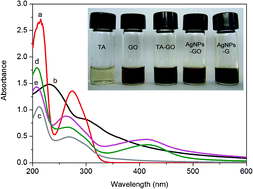
RSC Adv., 2012,2, 538-545
https://doi.org/10.1039/C1RA00641J
About this collection
We are very pleased to present our 10th Anniversary collection on Sensors for health and happiness!Looking back over the last 10 years, we would like to showcase some of the very best articles that have been published in RSC Advances. Many of these papers have been cited hundreds of times, providing valuable advances for further research, and some continue to be among the journal’s most downloaded articles as of today.
We hope you enjoy our 10th Anniversary collection on Sensors for health and happiness!